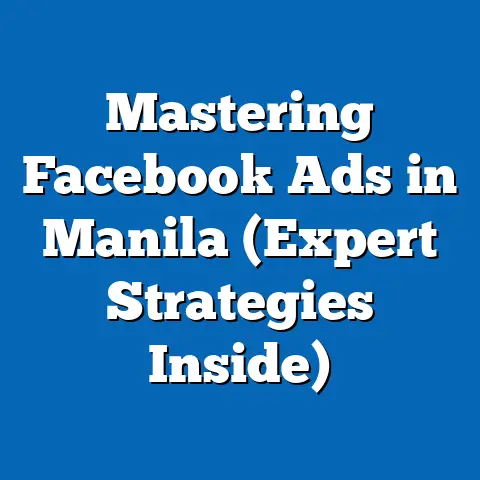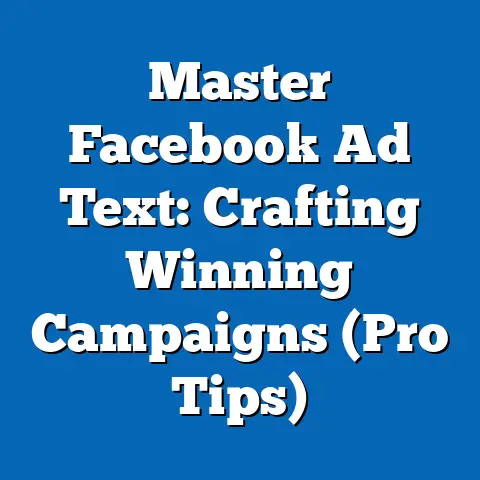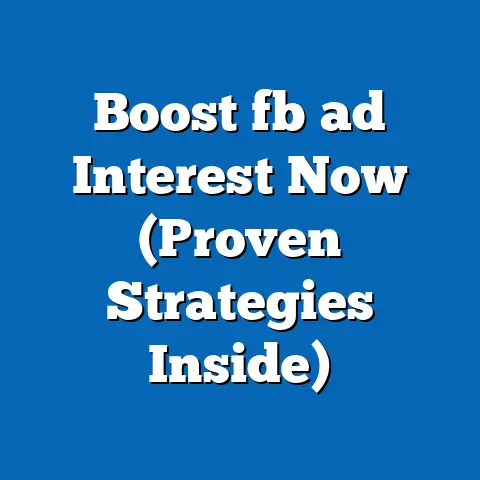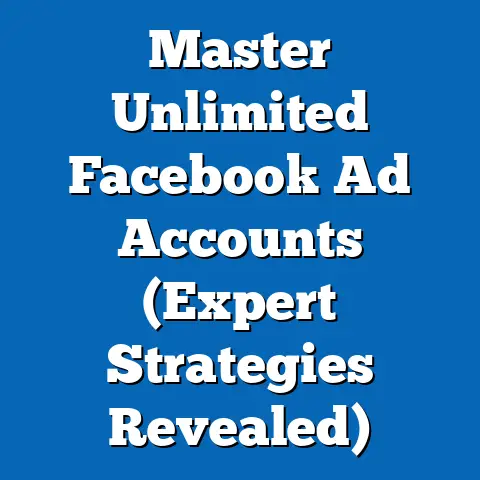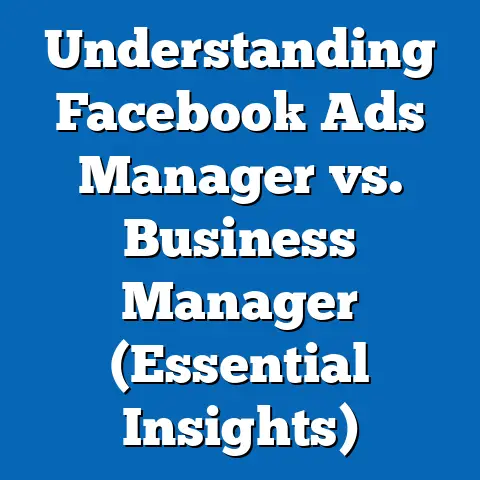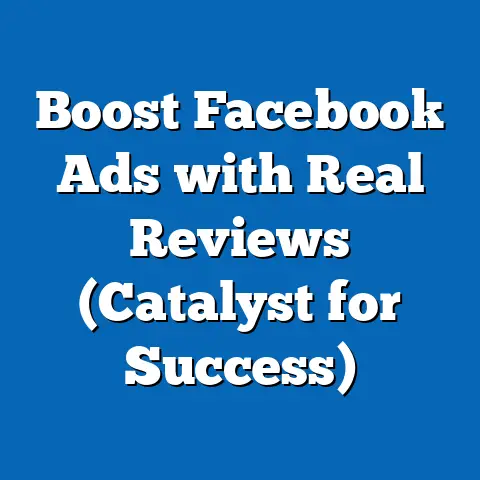Master Safe Zone Facebook Ads (Proven Strategies Revealed)
Have you ever wondered why some businesses seem to effortlessly attract customers on Facebook, while others struggle to even get a “like”? The answer often lies in understanding and operating within the “Safe Zone” of Facebook advertising.
Introduction: Navigating the Facebook Ad Landscape
In today’s digital world, Facebook advertising is no longer optional; it’s a necessity for businesses of all sizes. With billions of active users, Facebook offers an unparalleled platform to reach potential customers, build brand awareness, and drive sales. However, the landscape can be tricky. One wrong move – a poorly targeted ad, a misleading message, or simply a lack of understanding of the platform – and you can quickly burn through your budget with little to show for it. That’s where the concept of the “Safe Zone” comes in.
When I talk about the “Safe Zone” in Facebook advertising, I’m referring to a set of proven strategies and best practices that minimize risk and maximize your return on investment (ROI). It’s about making informed decisions, understanding your audience, and crafting ads that resonate without breaking the bank or violating Facebook’s policies. It’s about being smart, strategic, and, well, safe!
Understanding the Facebook Advertising Ecosystem
Before diving into specific strategies, it’s crucial to understand the broader Facebook advertising ecosystem. Think of it as a living, breathing organism, constantly evolving and adapting. Understanding its components and how they interact is key to navigating it successfully.
A Quick Tour of the Facebook Ad Platform
Facebook’s advertising platform, now often referred to as Meta Ads Manager, offers a diverse range of ad formats to suit different marketing objectives. Let’s take a quick look at some of the most popular:
-
Image Ads: These are the simplest form of Facebook ads, consisting of a single image, headline, and description. They’re great for showcasing products or services in a visually appealing way. I’ve personally seen image ads work wonders for e-commerce businesses, especially when the product photography is high-quality and attention-grabbing.
-
Video Ads: Video ads are incredibly engaging and can be used to tell stories, demonstrate product features, or simply capture attention. They can be short and sweet or longer and more in-depth, depending on your message and target audience. I once ran a video ad for a local restaurant that featured a chef preparing a signature dish, and the response was phenomenal, driving a significant increase in reservations.
-
Carousel Ads: Carousel ads allow you to showcase multiple images or videos in a single ad unit, each with its own headline, description, and link. This format is perfect for highlighting different products, features, or aspects of your brand. I’ve found carousel ads to be particularly effective for e-commerce businesses with a wide range of products.
-
Collection Ads: Collection ads are designed for mobile users and feature a cover image or video followed by a selection of products. When users click on the ad, they’re taken to a full-screen experience where they can browse and purchase products directly. This format is ideal for driving sales on mobile devices.
-
Lead Ads: Lead ads are designed to collect leads directly from Facebook without requiring users to visit your website. They feature a pre-populated form that users can fill out with their contact information. This format is great for generating leads for sales teams or building an email list. I’ve used lead ads extensively for service-based businesses like real estate agents and insurance providers.
-
Instant Experience Ads: These full-screen, mobile-optimized ads provide an immersive experience for users, allowing them to explore products, watch videos, and browse content without leaving Facebook. They’re great for telling stories and creating memorable brand experiences.
Image Ads: These are the simplest form of Facebook ads, consisting of a single image, headline, and description. They’re great for showcasing products or services in a visually appealing way. I’ve personally seen image ads work wonders for e-commerce businesses, especially when the product photography is high-quality and attention-grabbing.
Video Ads: Video ads are incredibly engaging and can be used to tell stories, demonstrate product features, or simply capture attention. They can be short and sweet or longer and more in-depth, depending on your message and target audience. I once ran a video ad for a local restaurant that featured a chef preparing a signature dish, and the response was phenomenal, driving a significant increase in reservations.
Carousel Ads: Carousel ads allow you to showcase multiple images or videos in a single ad unit, each with its own headline, description, and link. This format is perfect for highlighting different products, features, or aspects of your brand. I’ve found carousel ads to be particularly effective for e-commerce businesses with a wide range of products.
Collection Ads: Collection ads are designed for mobile users and feature a cover image or video followed by a selection of products. When users click on the ad, they’re taken to a full-screen experience where they can browse and purchase products directly. This format is ideal for driving sales on mobile devices.
Lead Ads: Lead ads are designed to collect leads directly from Facebook without requiring users to visit your website. They feature a pre-populated form that users can fill out with their contact information. This format is great for generating leads for sales teams or building an email list. I’ve used lead ads extensively for service-based businesses like real estate agents and insurance providers.
Instant Experience Ads: These full-screen, mobile-optimized ads provide an immersive experience for users, allowing them to explore products, watch videos, and browse content without leaving Facebook. They’re great for telling stories and creating memorable brand experiences.
These are just a few examples of the many ad formats available on Facebook. The best format for your business will depend on your specific objectives, target audience, and creative assets.
The Power of Targeting and Audience Segmentation
One of the biggest advantages of Facebook advertising is its powerful targeting capabilities. Facebook’s algorithms analyze vast amounts of data to deliver ads to the right users based on their demographics, interests, behaviors, and more. This level of precision allows you to reach your ideal customers with laser-like accuracy.
Here are some of the key targeting options available on Facebook:
-
Demographics: Target users based on age, gender, education, relationship status, job title, and more.
-
Interests: Target users based on their interests, hobbies, and passions. This is where you can really hone in on your target audience. For example, if you’re selling fitness equipment, you can target users who are interested in fitness, weightlifting, yoga, etc.
-
Behaviors: Target users based on their online behaviors, such as purchase history, device usage, and travel habits.
-
Custom Audiences: Create custom audiences based on your existing customer data, such as email lists, website visitors, or app users. This allows you to retarget users who have already interacted with your business.
-
Lookalike Audiences: Create lookalike audiences based on your custom audiences. Facebook will identify users who share similar characteristics and behaviors with your existing customers, allowing you to expand your reach to new potential customers.
Demographics: Target users based on age, gender, education, relationship status, job title, and more.
Interests: Target users based on their interests, hobbies, and passions. This is where you can really hone in on your target audience. For example, if you’re selling fitness equipment, you can target users who are interested in fitness, weightlifting, yoga, etc.
Behaviors: Target users based on their online behaviors, such as purchase history, device usage, and travel habits.
Custom Audiences: Create custom audiences based on your existing customer data, such as email lists, website visitors, or app users. This allows you to retarget users who have already interacted with your business.
Lookalike Audiences: Create lookalike audiences based on your custom audiences. Facebook will identify users who share similar characteristics and behaviors with your existing customers, allowing you to expand your reach to new potential customers.
The key to successful targeting is to combine these options strategically to create highly specific audiences that are most likely to be interested in your products or services. I’ve found that the more specific you are with your targeting, the higher your conversion rates will be.
Statistics and Case Studies: Proof That Facebook Ads Work
If you’re still on the fence about Facebook advertising, consider these statistics:
- Facebook has nearly 3 billion monthly active users, making it the largest social media platform in the world.
- The average Facebook user spends nearly 20 minutes per day on the platform.
- Facebook ads have an average click-through rate (CTR) of around 0.9%.
- Businesses earn an average of \$4.20 in revenue for every \$1 spent on Facebook ads.
These numbers speak for themselves. When executed correctly, Facebook ads can be a powerful tool for driving business growth.
Numerous case studies also demonstrate the effectiveness of Facebook advertising. For example, a small e-commerce business that sells handmade jewelry saw a 300% increase in sales after implementing a targeted Facebook ad campaign. A local restaurant increased its reservations by 50% after running a video ad showcasing its signature dishes. The possibilities are endless.
Takeaway: Understanding the Facebook advertising ecosystem, including ad formats, targeting options, and proven success stories, is the first step towards mastering Facebook ads in the Safe Zone.
Identifying Your Safe Zone
Now that you have a basic understanding of the Facebook advertising ecosystem, let’s talk about identifying your Safe Zone. This is where you define the boundaries within which you feel comfortable experimenting and investing in Facebook ads.
What is the Safe Zone?
For me, the Safe Zone represents a balance between risk and reward. It’s about making informed decisions, understanding your limitations, and focusing on strategies that are most likely to deliver positive results. It’s not about avoiding risk altogether, but rather about mitigating risk and maximizing your chances of success.
Think of it like investing in the stock market. You wouldn’t put all your money into a single, high-risk stock. Instead, you’d diversify your portfolio, investing in a mix of low-risk and high-risk assets. Similarly, in Facebook advertising, you want to start with low-risk strategies that you know are likely to work and then gradually experiment with higher-risk strategies as you gain more experience and confidence.
Understanding Your Brand, Audience, and Objectives
The foundation of your Safe Zone is a deep understanding of your brand, your audience, and your objectives. Without this understanding, you’ll be flying blind, making decisions based on guesswork rather than data.
-
Your Brand: What are your brand values? What is your unique selling proposition (USP)? What is your brand voice? These are all important questions to answer before you start advertising on Facebook. Your ads should be consistent with your brand identity and should accurately reflect what your business stands for.
-
Your Audience: Who are your ideal customers? What are their demographics, interests, and behaviors? What are their pain points? What motivates them to buy? The more you know about your audience, the better you’ll be able to target your ads and craft compelling messages that resonate with them.
-
Your Objectives: What do you want to achieve with your Facebook ads? Do you want to increase brand awareness? Generate leads? Drive sales? The answer to this question will determine your ad format, targeting strategy, and bidding strategy.
Your Brand: What are your brand values? What is your unique selling proposition (USP)? What is your brand voice? These are all important questions to answer before you start advertising on Facebook. Your ads should be consistent with your brand identity and should accurately reflect what your business stands for.
Your Audience: Who are your ideal customers? What are their demographics, interests, and behaviors? What are their pain points? What motivates them to buy? The more you know about your audience, the better you’ll be able to target your ads and craft compelling messages that resonate with them.
Your Objectives: What do you want to achieve with your Facebook ads? Do you want to increase brand awareness? Generate leads? Drive sales? The answer to this question will determine your ad format, targeting strategy, and bidding strategy.
Assessing Your Current Ad Performance
If you’ve already been advertising on Facebook, it’s important to assess your current ad performance before making any changes. Take a look at your key performance indicators (KPIs), such as click-through rate (CTR), cost per click (CPC), conversion rate, and return on ad spend (ROAS). What’s working well? What’s not working so well?
Identify areas for improvement and set realistic goals for your future campaigns. For example, if your CTR is low, you might want to experiment with different ad copy or visuals. If your conversion rate is low, you might want to improve your landing page or retarget users who have already visited your website.
Creating Audience Personas
One of the best ways to understand your audience is to create audience personas. These are fictional representations of your ideal customers based on research and data. Each persona should include information about their demographics, interests, behaviors, pain points, and motivations.
For example, let’s say you’re selling organic baby food. One of your audience personas might be “Sarah, the Stay-at-Home Mom.” Sarah is a 30-year-old stay-at-home mom with two young children. She’s passionate about healthy eating and wants to provide her children with the best possible nutrition. She’s active on social media and frequently searches for information about organic baby food.
By creating detailed audience personas like Sarah, you can gain a deeper understanding of your target audience and craft ads that speak directly to their needs and desires.
Takeaway: Identifying your Safe Zone involves understanding your brand, audience, and objectives, assessing your current ad performance, and creating audience personas. This foundation will help you make informed decisions and focus on strategies that are most likely to deliver positive results.
Proven Strategies for Safe Zone Facebook Ads
Now that you’ve identified your Safe Zone, let’s dive into some proven strategies for creating effective Facebook ads. These strategies are designed to minimize risk and maximize your chances of success.
Crafting Compelling Ad Copy
Your ad copy is one of the most important elements of your Facebook ad. It’s what grabs people’s attention and persuades them to take action. Here are some tips for crafting compelling ad copy:
-
Write clear and concise headlines: Your headline is the first thing people will see, so it needs to be attention-grabbing and relevant to your target audience. Keep it short and sweet, and focus on the benefits of your product or service.
-
Use strong call-to-actions (CTAs): Your CTA tells people what you want them to do next. Use strong action verbs like “Shop Now,” “Learn More,” or “Get Started.” Make your CTA stand out visually by using a button or bold text.
-
Highlight the benefits, not just the features: People don’t care about the features of your product or service; they care about the benefits. Focus on how your product or service will solve their problems or improve their lives.
-
Use emotional triggers: Tap into people’s emotions to create a connection and persuade them to take action. Use words that evoke feelings of happiness, excitement, fear, or urgency.
-
Keep it relevant: Your ad copy should be relevant to your target audience and the ad creative. Don’t try to be too clever or creative if it means sacrificing clarity and relevance.
Write clear and concise headlines: Your headline is the first thing people will see, so it needs to be attention-grabbing and relevant to your target audience. Keep it short and sweet, and focus on the benefits of your product or service.
Use strong call-to-actions (CTAs): Your CTA tells people what you want them to do next. Use strong action verbs like “Shop Now,” “Learn More,” or “Get Started.” Make your CTA stand out visually by using a button or bold text.
Highlight the benefits, not just the features: People don’t care about the features of your product or service; they care about the benefits. Focus on how your product or service will solve their problems or improve their lives.
Use emotional triggers: Tap into people’s emotions to create a connection and persuade them to take action. Use words that evoke feelings of happiness, excitement, fear, or urgency.
Keep it relevant: Your ad copy should be relevant to your target audience and the ad creative. Don’t try to be too clever or creative if it means sacrificing clarity and relevance.
Here are some examples of high-performing ad copy across different industries:
-
E-commerce: “Shop our new collection of handmade jewelry and add a touch of sparkle to your wardrobe. Limited-time offer: Get 20% off your first order with code WELCOME20.”
-
Service-based business: “Are you tired of dealing with a leaky roof? Our experienced roofing contractors can provide fast, reliable repairs at an affordable price. Get a free estimate today!”
-
Software company: “Streamline your workflow and boost your productivity with our powerful project management software. Try it free for 14 days!”
E-commerce: “Shop our new collection of handmade jewelry and add a touch of sparkle to your wardrobe. Limited-time offer: Get 20% off your first order with code WELCOME20.”
Service-based business: “Are you tired of dealing with a leaky roof? Our experienced roofing contractors can provide fast, reliable repairs at an affordable price. Get a free estimate today!”
Software company: “Streamline your workflow and boost your productivity with our powerful project management software. Try it free for 14 days!”
Visuals That Capture Attention
In today’s visually driven world, your ad visuals are just as important as your ad copy. Here are some tips for creating eye-catching visuals:
-
Use high-quality images and videos: Your visuals should be clear, sharp, and visually appealing. Avoid using blurry or pixelated images.
-
Choose visuals that are relevant to your target audience: Your visuals should be relevant to your target audience and the ad copy. Use images and videos that resonate with their interests and values.
-
Use bright colors and bold designs: Bright colors and bold designs can help your ads stand out from the crowd. However, be careful not to overdo it, as too much color can be overwhelming.
-
Use faces: People are naturally drawn to faces, so using images or videos of people can help capture attention.
-
Test different visuals: Experiment with different images and videos to see what resonates best with your target audience.
Use high-quality images and videos: Your visuals should be clear, sharp, and visually appealing. Avoid using blurry or pixelated images.
Choose visuals that are relevant to your target audience: Your visuals should be relevant to your target audience and the ad copy. Use images and videos that resonate with their interests and values.
Use bright colors and bold designs: Bright colors and bold designs can help your ads stand out from the crowd. However, be careful not to overdo it, as too much color can be overwhelming.
Use faces: People are naturally drawn to faces, so using images or videos of people can help capture attention.
Test different visuals: Experiment with different images and videos to see what resonates best with your target audience.
You don’t need to be a professional designer to create great visuals for your Facebook ads. There are many free and affordable tools available, such as Canva and Adobe Spark, that can help you create eye-catching graphics and videos.
A/B Testing for Success
A/B testing, also known as split testing, is the process of comparing two versions of an ad to see which one performs better. It’s a crucial step in optimizing your Facebook ads and ensuring that you’re getting the best possible results.
Here’s a step-by-step guide on how to conduct A/B tests effectively:
-
Identify what you want to test: Choose one element of your ad to test, such as the headline, image, CTA, or targeting.
-
Create two versions of your ad: Create two versions of your ad that are identical except for the element you’re testing.
-
Run your ads: Run your ads simultaneously and track their performance.
-
Analyze the results: After a certain period of time (usually a few days or weeks), analyze the results to see which ad performed better.
-
Implement the winning ad: Implement the winning ad and continue testing other elements of your ad to further optimize your performance.
Identify what you want to test: Choose one element of your ad to test, such as the headline, image, CTA, or targeting.
Create two versions of your ad: Create two versions of your ad that are identical except for the element you’re testing.
Run your ads: Run your ads simultaneously and track their performance.
Analyze the results: After a certain period of time (usually a few days or weeks), analyze the results to see which ad performed better.
Implement the winning ad: Implement the winning ad and continue testing other elements of your ad to further optimize your performance.
For example, let’s say you want to test two different headlines for your ad. You would create two versions of your ad that are identical except for the headline. You would then run your ads simultaneously and track their performance. After a week, you would analyze the results to see which headline generated more clicks or conversions.
Retargeting and Custom Audiences
Retargeting is the process of showing ads to people who have already interacted with your business, such as website visitors, app users, or email subscribers. It’s one of the most effective strategies for increasing conversion rates and driving sales.
When I first started using retargeting, I was amazed at the results. I was able to bring back users who had abandoned their shopping carts, remind them of products they had viewed, and ultimately convert them into paying customers.
Here’s how to create custom audiences and lookalike audiences for better targeting:
-
Create a custom audience: Go to the “Audiences” section in Facebook Ads Manager and click “Create Audience.” Choose the type of custom audience you want to create, such as website visitors, app users, or email subscribers.
-
Upload your data: Upload your data to Facebook and match it to Facebook users.
-
Create a lookalike audience: Once you’ve created a custom audience, you can create a lookalike audience based on that audience. Facebook will identify users who share similar characteristics and behaviors with your custom audience.
-
Target your ads: Target your ads to your custom audiences and lookalike audiences.
Create a custom audience: Go to the “Audiences” section in Facebook Ads Manager and click “Create Audience.” Choose the type of custom audience you want to create, such as website visitors, app users, or email subscribers.
Upload your data: Upload your data to Facebook and match it to Facebook users.
Create a lookalike audience: Once you’ve created a custom audience, you can create a lookalike audience based on that audience. Facebook will identify users who share similar characteristics and behaviors with your custom audience.
Target your ads: Target your ads to your custom audiences and lookalike audiences.
Budgeting and Bidding Strategies
Budgeting and bidding are crucial aspects of Facebook advertising. You need to set a budget that you’re comfortable with and choose a bidding strategy that aligns with your objectives.
Here are some budgeting options available on Facebook Ads Manager:
-
Daily Budget: Set a daily budget that you’re willing to spend on your ads each day.
-
Lifetime Budget: Set a lifetime budget that you’re willing to spend on your ads over the entire campaign duration.
Daily Budget: Set a daily budget that you’re willing to spend on your ads each day.
Lifetime Budget: Set a lifetime budget that you’re willing to spend on your ads over the entire campaign duration.
When it comes to bidding strategies, you have two main options:
-
Automatic Bidding: Let Facebook automatically set your bids based on your budget and objectives. This is a good option for beginners, as it takes the guesswork out of bidding.
-
Manual Bidding: Set your bids manually based on your own research and analysis. This option gives you more control over your bids, but it also requires more expertise.
Automatic Bidding: Let Facebook automatically set your bids based on your budget and objectives. This is a good option for beginners, as it takes the guesswork out of bidding.
Manual Bidding: Set your bids manually based on your own research and analysis. This option gives you more control over your bids, but it also requires more expertise.
If you’re just starting out, I recommend using automatic bidding. As you gain more experience, you can experiment with manual bidding to see if you can improve your results.
Takeaway: Proven strategies for Safe Zone Facebook ads include crafting compelling ad copy, using visuals that capture attention, A/B testing for success, retargeting and custom audiences, and optimizing your budgeting and bidding strategies.
Analyzing Performance Metrics
Creating great ads is only half the battle. You also need to track your performance and make adjustments as needed. Here are some key performance indicators (KPIs) to track:
-
Reach: The number of unique people who saw your ad.
-
Impressions: The number of times your ad was displayed.
-
Click-Through Rate (CTR): The percentage of people who saw your ad and clicked on it.
-
Cost Per Click (CPC): The average cost you paid for each click on your ad.
-
Conversion Rate: The percentage of people who clicked on your ad and completed a desired action, such as making a purchase or filling out a form.
-
Return on Ad Spend (ROAS): The amount of revenue you generated for every dollar you spent on ads.
Reach: The number of unique people who saw your ad.
Impressions: The number of times your ad was displayed.
Click-Through Rate (CTR): The percentage of people who saw your ad and clicked on it.
Cost Per Click (CPC): The average cost you paid for each click on your ad.
Conversion Rate: The percentage of people who clicked on your ad and completed a desired action, such as making a purchase or filling out a form.
Return on Ad Spend (ROAS): The amount of revenue you generated for every dollar you spent on ads.
Facebook Ads Manager provides a wealth of data and analytics that you can use to track your performance. You can also use third-party software, such as Google Analytics, to get a more comprehensive view of your results.
The key is to interpret the data and make data-driven decisions to enhance your ad strategies. For example, if your CTR is low, you might want to experiment with different ad copy or visuals. If your conversion rate is low, you might want to improve your landing page or retarget users who have already visited your website.
Takeaway: Analyzing performance metrics is crucial for optimizing your Facebook ads and ensuring that you’re getting the best possible results.
Case Studies of Successful Safe Zone Facebook Ads
Let’s take a look at a few case studies of businesses that have successfully implemented Safe Zone strategies in their Facebook advertising campaigns:
-
Case Study 1: Local Bakery A local bakery wanted to increase its brand awareness and drive more foot traffic to its store. They created a Facebook ad campaign targeting people within a 5-mile radius of their store who were interested in baking, desserts, and local businesses. Their ads featured mouth-watering photos of their pastries and cakes and included a special offer for first-time customers. As a result, they saw a 20% increase in foot traffic and a 15% increase in sales.
-
Case Study 2: Online Clothing Store An online clothing store wanted to increase its sales and acquire new customers. They created a Facebook ad campaign targeting women aged 25-45 who were interested in fashion, online shopping, and specific clothing brands. Their ads featured stylish photos of their clothing and included a link to their website. They also used retargeting to show ads to people who had visited their website but hadn’t made a purchase. As a result, they saw a 50% increase in sales and a 30% increase in new customers.
Case Study 1: Local Bakery A local bakery wanted to increase its brand awareness and drive more foot traffic to its store. They created a Facebook ad campaign targeting people within a 5-mile radius of their store who were interested in baking, desserts, and local businesses. Their ads featured mouth-watering photos of their pastries and cakes and included a special offer for first-time customers. As a result, they saw a 20% increase in foot traffic and a 15% increase in sales.
Case Study 2: Online Clothing Store An online clothing store wanted to increase its sales and acquire new customers. They created a Facebook ad campaign targeting women aged 25-45 who were interested in fashion, online shopping, and specific clothing brands. Their ads featured stylish photos of their clothing and included a link to their website. They also used retargeting to show ads to people who had visited their website but hadn’t made a purchase. As a result, they saw a 50% increase in sales and a 30% increase in new customers.
These case studies demonstrate the power of Safe Zone strategies in Facebook advertising. By understanding your audience, crafting compelling ads, and tracking your performance, you can achieve similar results for your business.
Takeaway: Case studies provide valuable insights into how other businesses have successfully implemented Safe Zone strategies in their Facebook advertising campaigns.
Conclusion
Mastering Safe Zone Facebook Ads is essential for business growth in today’s digital landscape. By understanding the Facebook advertising ecosystem, identifying your Safe Zone, implementing proven strategies, analyzing performance metrics, and learning from case studies, you can navigate the complexities of Facebook advertising with confidence and achieve sustainable success.
Remember, Facebook advertising is an ongoing process. It requires constant learning, experimentation, and optimization. Don’t be afraid to try new things, but always stay within your Safe Zone and make data-driven decisions.
Call to Action
Now it’s your turn! Experiment with the strategies discussed in this article and start your journey towards mastering Facebook ads in the Safe Zone. The potential rewards are enormous, so don’t wait any longer. Start today and see the difference that Safe Zone strategies can make for your business.

